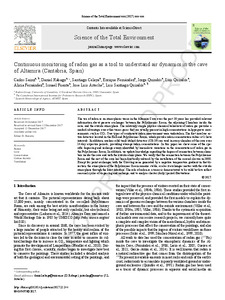Por favor, use este identificador para citar o enlazar este ítem:
http://hdl.handle.net/20.500.11765/11779
Continuous monitoring of radon gas as a tool to understand air dynamics in the cave of Altamira (Cantabria, Spain)
| Título : | Continuous monitoring of radon gas as a tool to understand air dynamics in the cave of Altamira (Cantabria, Spain) |
| Autor : | Sainz, Carlos; Rábago, Daniel; Celaya, Santiago; Fernández López, Enrique; Quindós, Jorge; Quindós López, Luis; Fernández, Alicia; Fuente Merino, Ismael; Arteche García, José Luis

|
| Palabras clave : | Radon; Cave; Conservation; Carbon dioxide; Ventilation |
| Fecha de publicación : | 2018 |
| Editor: | Elsevier |
| Citación : | Science of the Total Environment. 2018, 624, p. 416-423 |
| Versión del editor: | https://dx.doi.org/10.1016/j.scitotenv.2017.12.146 |
| Resumen : | The use of radon as an atmospheric tracer in the Altamira Cave over the past 30 years has provided relevant information about gaseous exchanges between the Polychromes Room, the adjoining Chambers inside the cave, and the outside atmosphere. The relatively simple physico-chemical behaviour of radon gas provides a marked advantage over other tracer gases that are usually present in high concentrations in hypogeous environments, such as CO2. Two types of continuous radon measurement were undertaken. The first involves active detectors located in the Hall and Polychromes Room, which provide radon concentration values at 1-hour intervals. In addition, nuclear solid track etched detectors (CR-39) are used in every chamber of the cave over 14-day exposure periods, providing average radon concentrations. In this paper we show some of the specific degassing and recharge events identified by anomalous variations in the concentration of radon gas in the Polychromes Room. In addition, we update knowledge regarding the degree of connection between chambers inside the cave and with the outside atmosphere. We verify that the connection between the Polychromes Room and the rest of the cave has been drastically reduced by the installation of the second closure in 2008. Except for point exchanges with the Crossing zone generated by a negative temperature gradient in that direction, the atmosphere of the Polychromes Room remains stable, or else it exchanges matter with the outside atmosphere through the karst interface. The role of radon as a tracer is demonstrated to be valid both to reflect seasonal cycles of degassing and recharge, and to analyse shorter (daily) period fluctuations. |
| Patrocinador: | This research was funded by the Project “Estudios analíticos para una propuesta de accesibilidad pública de la Cueva de Altamira” funded by the Ministry of Education, Culture and Sports, Spain (MECD). |
| URI : | http://hdl.handle.net/20.500.11765/11779 |
| ISSN : | 0048-9697 1879-1026 |
| Colecciones: | Artículos científicos 2015-2018 |
Ficheros en este ítem:
| Fichero | Descripción | Tamaño | Formato | ||
|---|---|---|---|---|---|
| pagination_STOTEN_250... | 2,51 MB | Adobe PDF |  Visualizar/Abrir |
Los ítems de Arcimis están protegidos por una Licencia Creative Commons, salvo que se indique lo contrario.





